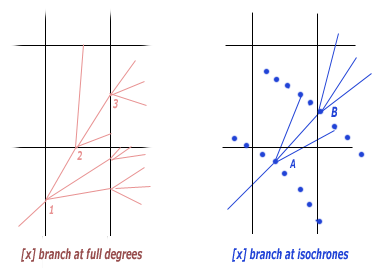mclean wrote:What does the "iso point spacing" setting do?
"iso point spacing"- This is the density of points kept in the isochrone.
Default is 1 (for 1% of the distance to start/destination).
If you increase to 2, for example, you will keep fewer points, more spaced,
resulting in a faster calculation but with a little less detail. This is a
new parameter.
Other important Weather Routing params are:
[ ]Add branches at isochrones - When the boat reaches the isochrone line,
do a round of track branching in several directions. [
x]Checked for VORG. [ ]Optional for VR (def-=unchecked)
[ ]Add branches at full degrees - Has to do with the rectangles
in VR races. Do a round of branching when the boat crosses a rectangle border.
[ ]Unchecked for VORG. [
x]checked for VR
( Parameter is badly misnamed, because it is actually the 30' lat/lon lines. )
isochrone interval - Time between sucessive isochrones, in hours.
For VORG use 1 or 0.5. For VR it can be longer (like 3).
Note that at isochrones the software does the tree prunning, reducing the point count.
Longer intervals will result in large number of points and sluggish calculation.
show isochrones - This controls which isochrones are exported to the desktop
when you click [Add isochrones] button. Default = 6h.
Tip: You don't have to restart the calculation if you change that,
because the track tree is still in the memory. You can change and insert the isochrones again.
number of branches - Number of track segments created at each branch generation.
The software adds one track direct to the destination and a number segments to each side,
spaced 5 deg (a little less in close hauled direction). So if you choose 21 for example,
you have 10 segments to each side (up to 50 degrees). In the classic polar database there
are 62 directions. Setting this param too high causes the computer to choque
 Max angle to the destination
Max angle to the destination - removes branches that point more this
angle to the destination. Using 110 for VORG.

